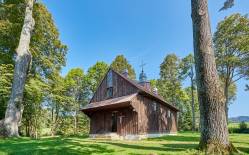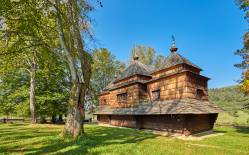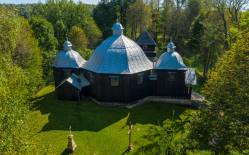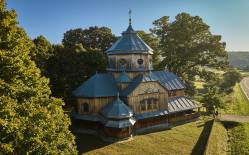The first reference to a tserkva existing here dates from 1533. The present Greek-Catholic Tserkva of St. Nicholas was built in 1790. According to a local tradition, it was once a manorial chapel and in 1770 it was awarded to the Ruthenian community in return for help with the construction of a Roman Catholic church. This would mean the original structure was built earlier.
After the local population was relocated in 1951 the tserkva was used as a storehouse. Attempts to hold Roman Catholic liturgical rites here were initiated in 1968 because the nearby church had been demolished by workers of the local State Agricultural Farm in the 1950s. The authorities, however, had the tserkva sealed. Ultimately the building was acquired by Roman Catholic Church in 1969, and a parish was established in Polana in 1982.
The two-part log church, oriented eastward, is clad with wood planks. The entrance to the narthex is covered with a mono-pitched roof supported on the protruding log tails. On the eastern wall of the chancel, we can see a trace of an oculus which once was here. The gable roof features a false lantern over the nave and turrets topped with onion cupolas over the narthex and the chancel.
In the chancel there is a flat ceiling, and in the nave a false barrel vault. The church is decorated inside with figural and ornamental paintings from 1937. These include a representation of New Testament Trinity on the nave ceiling, accompanied with seraphs located in the corners. Closer to the altar, on the ceiling, there is an inscription in Cyrillic letters informing about the founders, and saying: Gift from women in Polana. In the western part of the ceiling there is a representation of cross painted in a style of folk embroidery. On the eastern wall of the nave, we can see a scene from the Passion.
The neo-Gothic high altar holds a contemporary painting of the Transfiguration of Jesus. In the side altars there are icons of Christ as well as Madonna with Child. No original furnishings can be seen inside the church. A few icons from this tserkva are stored in museums. Icons depicting the Last Judgment (1400s), Sts. John and Paul (early 1600s) and Deisis (early 1600s) are in the holdings of the National Museum in Kraków. An icon of St. Nicholas (17th/18th century) can be seen in the Museum of Folk Architecture in Sanok.
In front of the tserkva there is a post-and-beam belfry built in 1922. The structure, with slightly slanted walls, is clad with wood planks and comprises two floors, outside marked with a skirt roof. In the nearby cemetery there are a few old tombstones.
Photo: Krystian Kłysewicz
Gallery

Recommended venues on the Trail



This website has been modernized with the financial support of the European Union under the Cross-Border Cooperation Programme Poland-Belarus-Ukraine 2014-2020. The responsibility for its content lies solely with the Podkarpackie Regional Tourism Board and cannot, in any case, be treated as a reflection of the position of the European Union, the Managing Authority, or the Joint Technical Secretariat of the Cross-Border Cooperation Programme Poland-Belarus-Ukraine 2014-2020.













